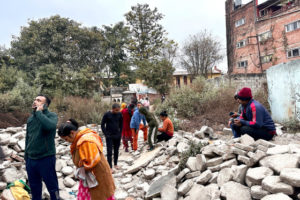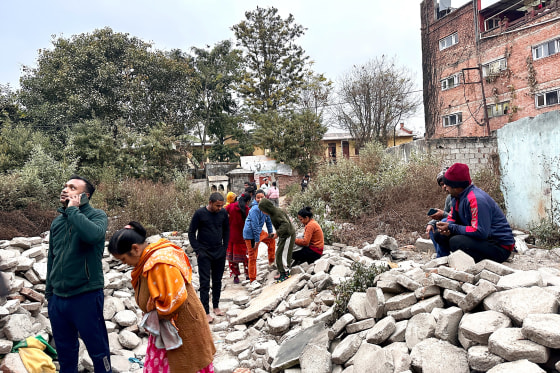
By Adeyemi Adekunle
A catastrophic earthquake shook the Tibetan plateau on Tuesday morning, claiming the lives of at least 95 people and injuring 130. The tremor, which measured 7.1 in magnitude, wreaked havoc across a serene region rich with religious and cultural significance.
Centered in Dingri County near Tibet’s holiest city of Shigatse, the disaster left thousands homeless and villages in ruins as rescue teams raced against time to reach remote areas cut off by debris.
Striking at just after 9 a.m. local time (8 p.m. ET Monday), the shallow quake, at a depth of six miles, unleashed its full destructive potential. Villagers were caught off guard, their homes collapsing within moments.
The epicenter, close to the Nepal border, lies in a picturesque yet vulnerable region dominated by mountains and known for its deep spiritual heritage. Shigatse, about 240 miles from Lhasa, the Tibetan capital, is the seat of the Panchen Lama, the second most important figure in Tibetan Buddhism after the Dalai Lama.
Within a radius of 12 miles from the quake’s origin, more than 6,900 residents in over two dozen settlements experienced widespread destruction. Reports from Chinese state broadcaster CCTV described the collapse of many homes, trapping numerous residents beneath rubble.
Photographs shared in the immediate aftermath revealed roads blocked by massive boulders, shattered buildings, and emergency workers struggling against harsh conditions to assess the devastation. Rescuers scrambled to reach areas rendered nearly inaccessible due to blocked highways, while images of collapsed structures and scattered personal belongings painted a haunting picture of lives upended in seconds.
Witnesses described the moment the quake struck as terrifying, with the earth roaring beneath them. Tsering, a farmer in a village near the epicenter, recalled his family fleeing outdoors as their home began to crumble.
“It felt like everything around us was shaking uncontrollably. We only had a few seconds to escape,” he said, his voice heavy with fear and grief. Across the region, similar stories emerged as thousands faced the stark reality of displacement amid freezing winter temperatures.
Shockwaves from the earthquake were felt far beyond Tibet, rippling across the border to Nepal’s capital, Kathmandu, 250 miles away. In the bustling city, residents were abruptly awakened as buildings swayed dangerously.
Memories of Nepal’s devastating 2015 earthquake, which claimed nearly 9,000 lives, came rushing back for many. However, no immediate damage was reported in Kathmandu this time.
Seismic activity is a grim reality in the Himalayan region, located on the collision zone of the Indian and Eurasian tectonic plates. The same forces that created the towering mountain range also render it one of the most earthquake-prone regions on Earth.
Experts at the U.S. Geological Survey (USGS) noted that over the past century, 10 earthquakes measuring 6.0 or greater have occurred within 150 miles of Tuesday’s epicenter, highlighting the region’s inherent geological risks.
For Tibetans, this disaster is an all-too-familiar tragedy. The Sichuan earthquake of 2008 claimed almost 70,000 lives, while Nepal’s devastating 2015 quake remains etched in collective memory as one of the region’s deadliest disasters.
Now, with Shigatse bearing significant damage, the scars left by Tuesday’s event run deep—not only physically but also spiritually. The city, home to ancient monasteries and religious relics, stands as a sacred center for Tibetan Buddhism.
Rescue and relief efforts began within hours of the quake. Chinese authorities mobilized nearly 1,500 emergency personnel, along with rescue dogs, heavy machinery, and supplies to reach the affected villages. Teams worked tirelessly to dig through rubble, stabilize compromised structures, and provide immediate care to survivors.
Makeshift shelters were set up to protect displaced families from the harsh winter conditions, while helicopters carried emergency supplies to areas unreachable by road.
Despite these efforts, the challenges are immense. Dingri County’s remoteness and its rugged, mountainous terrain complicate logistics. Fallen debris, coupled with aftershocks, has hindered rescue operations, delaying aid to some of the hardest-hit areas.
Early reports suggest the disaster could cause extensive long-term damage to infrastructure, making rebuilding a daunting task for this isolated region.
The earthquake’s reach extended beyond physical damage, sparking fear among neighboring countries. Nepal and India, also vulnerable to seismic activity in the Himalayan arc, were placed on high alert.
Nepalese authorities offered their condolences while monitoring potential aftershocks. Seismologists in the region warned that the risk of subsequent tremors remains high, and local communities have been urged to stay vigilant.
International humanitarian organizations have begun calling for increased aid, stressing that the harsh climate and remote location could exacerbate the crisis if relief efforts are delayed.
The United Nations Office for the Coordination of Humanitarian Affairs expressed concern, offering to coordinate assistance for those affected. With temperatures plunging in Tibet during January, timely intervention is essential to prevent further loss of life.
For the residents of Shigatse and its surrounding areas, the immediate aftermath is marked by grief, uncertainty, and resilience. Many mourn the loss of loved ones while searching for missing family members. Ngawang, a teacher in a nearby village, described the heartbreak of seeing his childhood home reduced to rubble. “Everything I knew is gone,” he said. “But we are a strong people. We will rebuild, just as we have done in the past.”
Tuesday’s earthquake is a tragic reminder of nature’s unpredictability and the fragility of human life in the face of immense natural forces.




